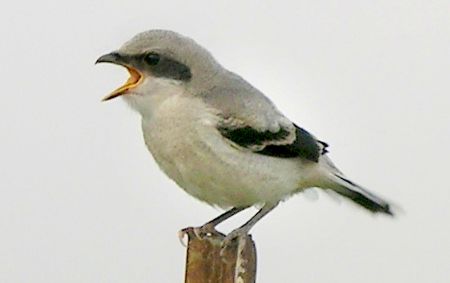by Valerie
February, 2012Loggerhead Shrike
The calls of most songbirds are melodious. That's probably why they are called "songbirds." However, the loggerhead shrike (Lanius ludovicianus) defies several presumptions about typical small perching birds, including what kind of vocalizations it should make. In my experience, shrikes sound more like miniature birds of prey. The individual pictured here is young, and was calling the way many fledgling birds do, to urge its parents to feed it. I've heard similar cries from shrikes that fly overhead as well. Though not a common bird, I occasionally see and hear this species on my morning walks and am always reminded of a tiny hawk, which seems in keeping with the feeding habits that have earned it the nickname "butcher bird." Shrikes are related to flycatchers, but their more robust beak is designed for prey slightly larger than flies. There is even a little hook at the end, which undoubtedly helps them tear into their victims, including grasshoppers, lizards, mice and small birds. The one tool this miniature raptor lacks, though, is a set of talons. Its feet are just like other perching birds, with normal-sized claws. To help steady its victim while it tears off pieces, the shrike impales it upon thorns, cactus spines, or the handy spikes on barbed wire fences. The instinct to skewer prey is so strong that the bird does it a lot and sometimes forgets to return to the remains. I've found parts of locusts and small rodents sun-dried on their hooks in the branches of shrubs, a grisly reminder of the curious habits of this unusual bird. |